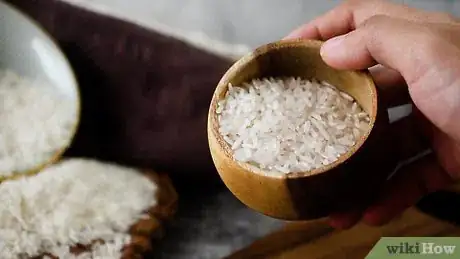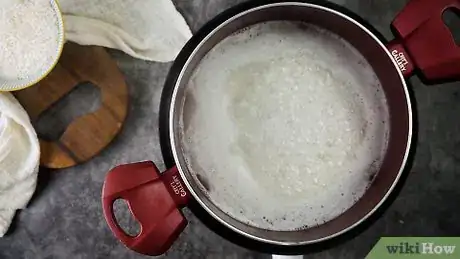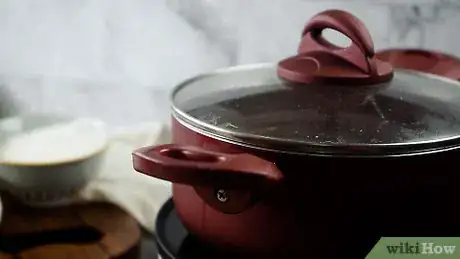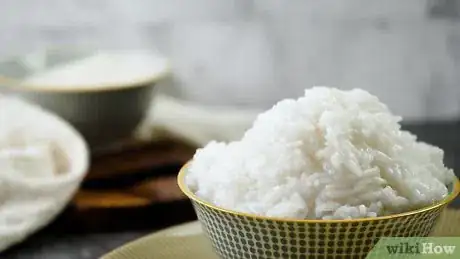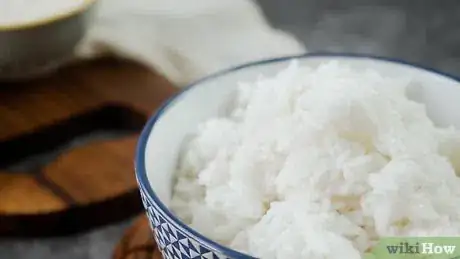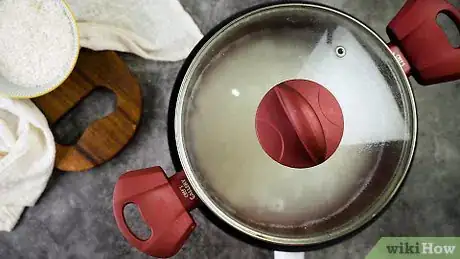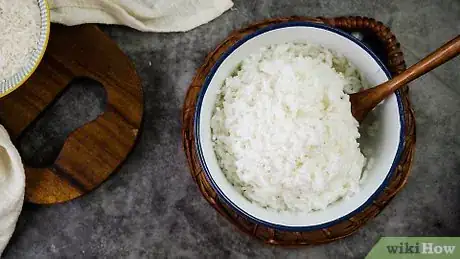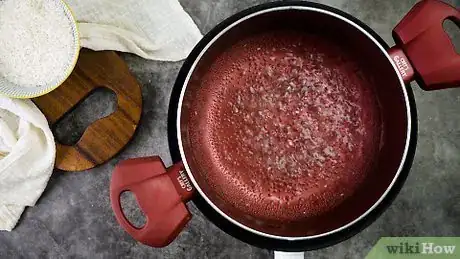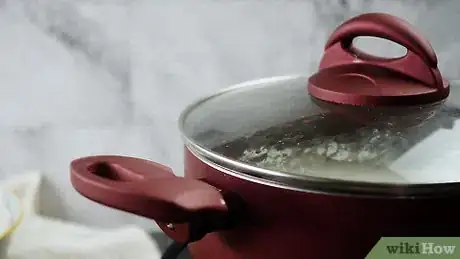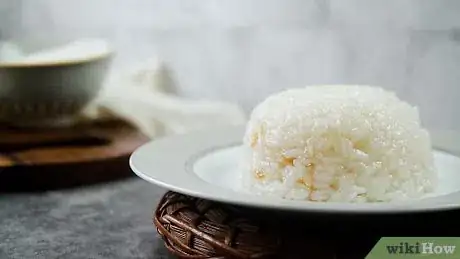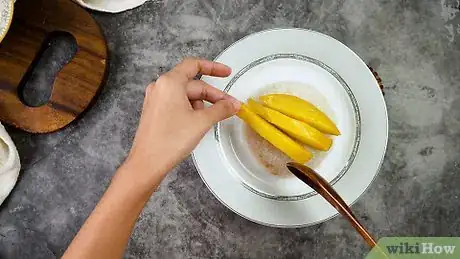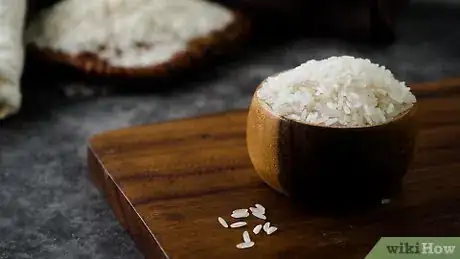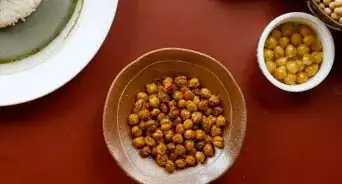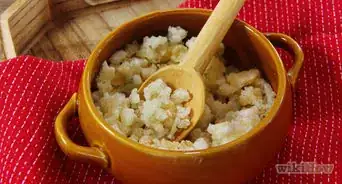This article was co-authored by JoAnna Minneci. JoAnna Minneci is a Professional Chef based in the Nashville, Tennessee area. With more than 18 years of experience, Chef JoAnna specializes in teaching others how to cook through private cooking lessons, team-building events, and wellness and nutrition classes. She has also appeared in numerous television shows on networks such as Bravo and Food Network. Chef JoAnna received Culinary Arts training from the Art Institute of California at Los Angeles. She is also certified in sanitation, nutrition, kitchen management, and cost control.
There are 8 references cited in this article, which can be found at the bottom of the page.
wikiHow marks an article as reader-approved once it receives enough positive feedback. In this case, 88% of readers who voted found the article helpful, earning it our reader-approved status.
This article has been viewed 1,527,921 times.
Sticky rice has a unique texture and flavor. It is used in many Japanese and Thai dishes. Unfortunately, it is not always easy to find. There are ways to cook regular, non-sticky rice so that it becomes somewhat stickier. This article will give you a few tips on how to cook regular, non-sticky rice so it becomes more sticky. It will also give you two recipes on how to make two popular "sticky rice" dishes, but with regular rice instead.
Ingredients
- 1 cup (200 grams) to 1 ½ cups (300 grams) rice
- 2 cups (450 milliliters) water
- Few tablespoons extra water
- 1 cup (200 grams) to 1 ½ cups (300 grams) rice
- 2 cups (450 milliliters) water
- 4 tablespoons rice vinegar
- 2 tablespoons sugar
- 1 teaspoon salt
Makes 4 servings
- 1 cup (200 grams) to 1 ½ cups (300 grams) rice
- 2 cups (450 milliliters) water
- 1 ½ cups (337.50 milliliters) coconut milk
- 1 cup (225 grams) white sugar
- ½ teaspoon salt
Sauce
- ½ cup (112.50 milliliters) coconut milk
- 1 tablespoon white sugar
- ¼ teaspoon salt
- 1 tablespoon tapioca starch
- 3 mangos, peeled and sliced
- 1 tablespoon toasted sesame seeds (optional)
Steps
Making Regular Rice Stickier
-
1Do not rinse the rice before you cook it. Most people rinse rice for sanitary purposes, and to get rid of the starch dust. Starch is what causes rice to become sticky and clump together. If you cannot bear to eat rice without washing it, then rinse it once or twice—but don't rinse so much that the water runs clear. You still want some of that starch left.
-
2Consider letting the rice soak in a pot of water before you cook it. Some people find that letting the rice soak in water helps it become stickier in the end. Try soaking it for 30 minutes to 4 hours. Drain the water once the rice has finished soaking.Advertisement
-
3
-
4Add 1 ½ cups (300 grams) of short-grain rice or 1 cup (200 grams) of medium or long-grain rice. Try to use the short-grain rice variety, if you can. Short-grain rice tends to have a higher starch content than medium or long-grain rice, which makes it slightly more sticky.
-
5Bring the water to a boil over high heat. Do not cover the pot with a lid.
-
6Reduce the heat once the water is boiling, and let the rice simmer for 10 minutes. At this point, you can place the lid on the pot.
-
7Turn the heat off once the rice has absorbed all of the water. You may notice some steam holes in the rice.[4]
-
8Leave the pot, covered, on the stove for 10 more minutes.[5] Rice gets stickier the longer you let it sit. If you make it a day or two ahead of time, your rice will be extra sticky. If you do plan on waiting that long, however, you might want to cover the rice and leave it in the fridge so that it doesn't dry out or spoil.
-
9Serve the rice. Transfer the rice to a serving plate. If you want, you can fluff it a little bit with a fork to make it less clumpy.
Making Sushi Sticky Rice
-
1Know what to expect. You may be able to get regular rice to taste similar to sushi rice with the help of the right seasoning. However, it is very difficult to get regular rice to have the same sticky consistency as sushi rice. You may be able to use the rice from this method in sashimi, bento, and sushi rolls, but you may find it too difficult to mold for nigiri.
-
2Bring 2 cups (450 milliliters) of water to a boil in a large pot.
-
3Add 1 ½ cups (300 grams) of short-grain rice or 1 cup (200 grams) of medium-grain rice. Try to use the short-grain rice variety, if you can. Short-grain rice tends to have a higher starch content than medium or long-grain rice, which makes it slightly more sticky.
- Both jasmine and basmati are considered to be medium-grain.
-
4Cover the pot with a lid and simmer for 15 minutes. The water will likely stop boiling for a few seconds when you add the rice. Wait for the water and rice start to boil again, then reduce the heat and cover the pot with a tight-fitting lid. Continue cooking the rice until all of the water is absorbed.
-
5Combine 4 tablespoons of rice vinegar, 2 tablespoons of sugar, and 1 teaspoon of salt in a small saucepan. Mix everything together with a spoon. This will be the seasoning for your sushi rice. It may also help your rice become a little more sticky.
-
6Bring the sushi rice seasoning to a boil over medium heat. Stir the seasoning with a fork or a small whisk until the sugar is dissolved.
-
7Remove the seasoning from the stove. Set it aside and let it cool.
-
8Transfer the rice to a glass bowl. During the next few steps, you want to avoid using anything made out of metal, or you will risk the vinegar picking up a metallic taste.
-
9Pour the seasoning over the rice. Do this while the rice is still hot. You don't have to use all of the seasoning if you want a less-intense flavor.
-
10Mix the rice and the seasoning together with a paddle. You can also use a spatula, but make sure that it is not made out of metal.
- Consider working in front of a fan, or having someone wave a paper fan over the bowl. This will help the rice cool down faster.
-
11Serve the rice while it is still warm. Japanese sticky rice is best while it is still warm, but not hot.
Making Mango Sticky Rice
-
1Fill a large pot with 2 cups (450 milliliters) of water and bring it to a boil.
-
2Add 1 ½ cups (300 grams) of short-grain rice or 1 cup (200 grams) of medium-grain rice. For best results, try to use a short-grain rice type.[6] Short-grain rice tends to be starchier than medium or long-grain rice by nature, so it might give your better results.
- Popular medium-grain rice varieties include jasmine and basmati.
-
3Cover the pot with a lid and simmer for 15 to 20 minutes. Reduce the heat to medium-low. Be sure to keep an eye on your pot so that it doesn't boil over.
-
4In another pot, combine 1 ½ cups (337.50 milliliters) of coconut milk, 1 cup (225 grams) of white sugar, and 1/2 teaspoon salt. Stir everything together with a spoon to combine. You will be using this to season your rice.
- To save time, consider doing this while the rice is cooking.
-
5Bring the coconut milk mixture to a boil over medium heat. Be sure to stir the mixture from time to time. This will prevent it from getting scorched.
-
6Stir the coconut milk mixture into the rice once the rice is done cooking. When the rice has finished cooking, take the rice pot off the stove and remove the cover. Pour the coconut milk mixture into the rice, and stir it using a fork or spatula.
-
7Set the seasoned rice aside for one hour. Put the cover back on the rice pot, and place the pot some place where it won't be disturbed. This will give the rice enough time to soak up the flavors from the coconut milk mixture.
-
8Combine ½ cup (112.50 milliliters) of coconut milk, 1 tablespoon of sugar, ¼ teaspoon of salt, and 1 tablespoon of tapioca starch in a saucepan. Stir everything together with a spoon. This will be your sauce. If you don't have any tapioca starch, you can also use cornstarch or arrowroot powder instead.[7]
-
9Bring the sauce to a boil. Be sure to stir the sauce from time to time so that it doesn't curdle or scorch.
-
10Prepare the mango. Start by peeling the mango. If your mango is ripe enough, you should be able to nick the skin with your knife, then pull the skin off. Once you have the mango peeled, cut it in half and remove the seed. Cut the mango into thin slices. Repeat this step for the other two mangoes.
-
11Scoop the rice onto four plates. You can create more servings than just four, but the portions will be smaller.
-
12Arrange the mango slices. You can set them down right next to the rice, or on top of the rice. If you are placing the slices on top of the rice, overlap them to create a fan-like shape.
-
13Drizzle the sauce over the mangoes and rice. If you want, you can also sprinkle some sesame seeds on top of the sauce.
- Keep in mind that, because you are not using sticky rice, the texture may not be quite the same as in the traditional dish.
What to Expect
-
1Know what to expect from these recipes. There is no real substitute for sticky rice; it is a type of rice (like brown rice) and not a dish (like fried rice). The flavor and texture of these recipes will be different because you are using regular rice. Also, be aware that even if you cook regular rice so that it becomes mushier or stickier, it still may not be sticky enough for nigiri-style sushi.
-
2Consider some substitutes. Are you looking to make sticky rice out of regular rice because you cannot find it in a store? If you can't find sticky rice anywhere, try searching for "sweet rice," or "glutinous rice." They are the same thing.[8]
Community Q&A
-
QuestionWhat kind of rice is normally used to make sticky rice?
 wikiHow Staff EditorThis answer was written by one of our trained team of researchers who validated it for accuracy and comprehensiveness.
wikiHow Staff EditorThis answer was written by one of our trained team of researchers who validated it for accuracy and comprehensiveness.
Staff Answer wikiHow Staff EditorStaff Answer“Sticky rice,” also known as “glutinous rice,” refers to a variety of different types or rice grown in Southeast and East Asia. Some common types include bora saul, bini dhan, kao hnyin, nuòmǐ, and mochigome.
wikiHow Staff EditorStaff Answer“Sticky rice,” also known as “glutinous rice,” refers to a variety of different types or rice grown in Southeast and East Asia. Some common types include bora saul, bini dhan, kao hnyin, nuòmǐ, and mochigome. -
QuestionIs sticky rice good for you?
 wikiHow Staff EditorThis answer was written by one of our trained team of researchers who validated it for accuracy and comprehensiveness.
wikiHow Staff EditorThis answer was written by one of our trained team of researchers who validated it for accuracy and comprehensiveness.
Staff Answer wikiHow Staff EditorStaff AnswerTrue sticky rice is sticky because it’s very high in starch. It’s also not very high in nutrients, so it isn’t the healthiest option. Avoid eating sticky rice if you have problems with high blood sugar.
wikiHow Staff EditorStaff AnswerTrue sticky rice is sticky because it’s very high in starch. It’s also not very high in nutrients, so it isn’t the healthiest option. Avoid eating sticky rice if you have problems with high blood sugar. -
QuestionWhat’s the difference between regular rice and sticky rice?
 wikiHow Staff EditorThis answer was written by one of our trained team of researchers who validated it for accuracy and comprehensiveness.
wikiHow Staff EditorThis answer was written by one of our trained team of researchers who validated it for accuracy and comprehensiveness.
Staff Answer wikiHow Staff EditorStaff AnswerSticky rice is higher in a certain type of starch, known as amylopectin, than other types of rice. That’s what gives it the distinctive sticky texture.
wikiHow Staff EditorStaff AnswerSticky rice is higher in a certain type of starch, known as amylopectin, than other types of rice. That’s what gives it the distinctive sticky texture.
Warnings
- Be aware that there is no real substitute for sticky rice or sushi rice. It is possible to cook regular rice so that it becomes stickier or mushier, but it will lack the particular flavor and texture that sticky rice is known for.⧼thumbs_response⧽
References
- ↑ Just One Cookbook, How to Make Sushi Rice
- ↑ All Recipes, Thai Sweet Sticky Rice
- ↑ The Hungry Moose, How to Cook Perfect White Rice on the Stove
- ↑ The Hungry Moose, How to Cook Perfect White Rice on the Stove
- ↑ The Hungry Moose, How to Cook Perfect White Rice on the Stove
- ↑ All Recipes, Thai Sweet Sticky Rice
- ↑ Food Subs, Starch Thickeners
- ↑ Tablespoon, How to Make Sticky Rice at Home
- ↑ Food Subs, Rice
- ↑ She Simmers, Thai Sticky Rice
- ↑ Tablespoon, How to Make Sticky Rice at Home
- Videos provided by Kwan Homsai
About This Article
To make sticky rice using regular rice, let the rice soak in water for at least 30 minutes before you cook it, which will help make it stickier in the end. Then, add 2 parts water and 1 part rice to a large pot. Bring the water to a boil and then reduce the heat. Let the rice simmer for 10 minutes with the pot covered or until the rice has absorbed all of the water. After 10 minutes, turn off the heat and let the rice sit for an additional 10 minutes with the lid still on. Finally, fluff the rice with a fork and serve! If you want to learn how to make sushi rice with regular rice, keep reading!
